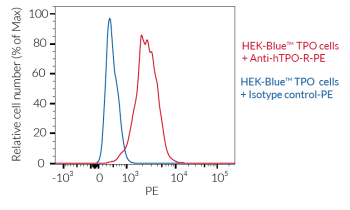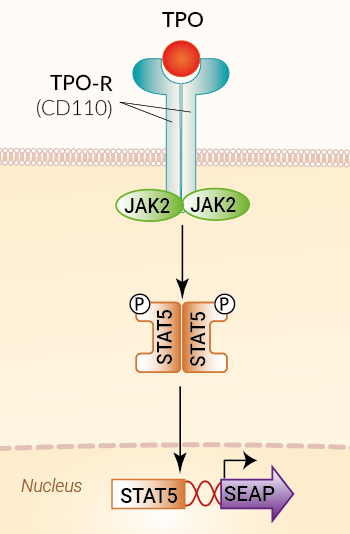HEK-Blue™ TPO Cells
-
Cat.code:
hkb-tpo
- Documents
ABOUT
Thrombopoietin reporter cells
HEK-Blue™ TPO cells are designed to monitor thrombopoietin (TPO)-induced STAT5 stimulation or inhibition through SEAP detection. This colorimetric bioassay can be used for screening activatory molecules, such as engineered cytokines, or inhibitory molecules, such as neutralizing antibodies.
HEK-Blue™ TPO cells respond specifically to recombinant human and mouse TPO (see figure). The reliable and consistent performance of HEK-Blue™ TPO cells makes them suitable for release assays of therapeutic molecules that inhibit the TPO pathway, such as monoclonal antibodies.
Key features
- Readily assessable STAT5-SEAP reporter activity
- Convenient readout using QUANTI-Blue™ Solution
- Strong response to human (h) & mouse (m) TPO
- Response to hIFN-α, hIFN-β, and IFN-γ
- Stability guaranteed for 20 passages
Applications
- Therapeutic development
- Drug screening
- Release assay
TPO is a key hematopoietic growth factor that plays a vital role in the regulation of megakaryocytopoiesis and the maintenance of hematopoietic stem cells (HSCs) [1].
Disclaimer: These cells are for internal research use only and are covered by a Limited Use License (See Terms and Conditions). Additional rights may be available.
SPECIFICATIONS
Specifications
TPO
Detection and quantification of human and mouse TPO activity.
Human TPO: 3 ng/ml - 100 ng/ml
Mouse TPO: 0.1 ng/ml - 10 ng/ml
Complete DMEM (see TDS)
Verified using Plasmotest™
Each lot is functionally tested and validated.
CONTENTS
Contents
-
Product:HEK-Blue™ TPO Cells
-
Cat code:hkb-tpo
-
Quantity:3-7 x 10^6 cells
- 1 ml Normocin® (50 mg/ml)
- 2 x 1 ml of HEK-Blue Selection (250X)
- 1 ml of QB reagent and 1 ml of QB buffer (sufficient to prepare 100 ml of QUANTI-Blue™ Solution, a SEAP detection reagent).
Shipping & Storage
- Shipping method: Dry ice
- Liquid nitrogen vapor
- Upon receipt, store immediately in liquid nitrogen vapor. Do not store cell vials at -80°C.
Storage:
Caution:
Details
Cell line description
HEK-Blue™ TPO cells were generated by stable transfection with the genes encoding for the human TPO receptor (TPO-R, aka CD110), human STAT5b, and a STAT5-inducible secreted embryonic alkaline phosphatase (SEAP) reporter. The binding of TPO to its receptor triggers a signaling cascade leading to the activation of STAT5 and the subsequent production of SEAP. This can be readily assessed in the supernatant using QUANTI-Blue™ Solution, a SEAP detection reagent.
HEK-Blue™ TPO cells detect human and murine TPO (see figures). Of note, as HEK293 cells endogenously express the receptors for type I and type II interferons (IFNs), these cells also respond to IFN-α/β and IFN-γ (see figures).
TPO background
TPO is the chief cytokine that regulates megakaryocyte production, signaling through its receptor (TPO-R; also known as c-Mpl). It also plays a vital role in the maintenance of hematopoietic stem cells (HSCs) [1]. TPO promotes the proliferation and differentiation of megakaryocytes and their specialized progenitors. Additionally, TPO drives platelet production and activity. The number of circulating platelets must be tightly controlled to avoid spontaneous bleeding or arterial occlusion and organ damage. Abnormal levels of TPO or mutations in its receptor are associated with blood disorders, such as thrombocytosis and thrombocytopenia. TPO is produced principally in the liver and is found in peripheral blood. TPO acts by binding to the extracellular portion of the cell surface TPO-R. Upon binding to its receptor, TPO activates JAK2/STAT5 signaling, which initiates transcriptional elements and the expression of TPO-inducible genes [2, 3].
1. Grozovsky R. et al., 2015. Novel mechanisms of platelet clearance and thrombopoietin regulation. Curr Opin Hematol 22(5):445-51.
2. Ghanima W. et al., 2019. Thrombopoietin receptor agonists: ten years later. Haematologica. 104(6):1112-23.
3. Hitchcock I. & Kaushansky K., 2014. Thrombopoietin from beginning to end. Br J Haematol. 165(2):259-68.
DOCUMENTS
Documents
Technical Data Sheet
Safety Data Sheet
Validation Data Sheet
Certificate of analysis
Need a CoA ?







